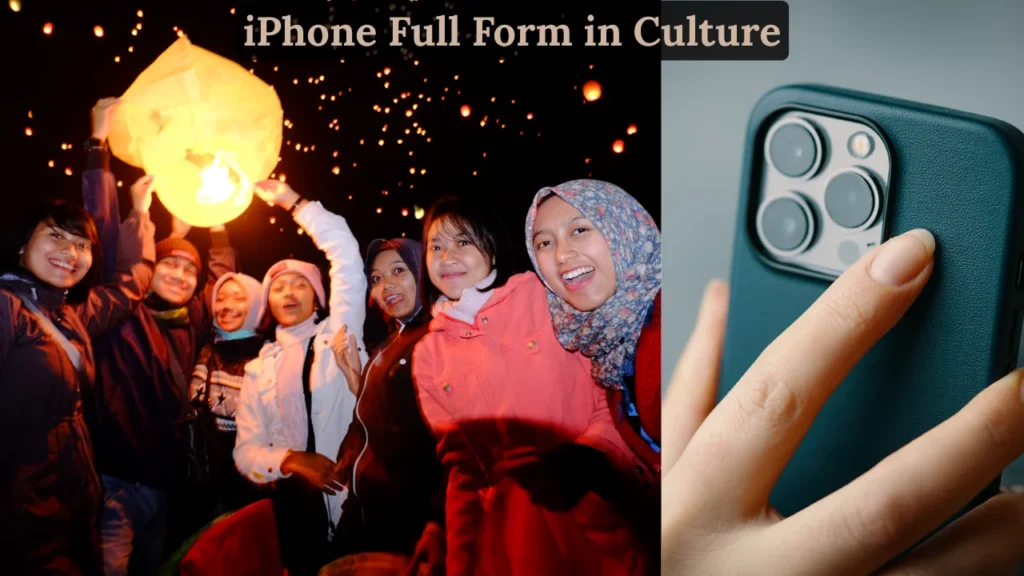iPhone Full Form in Information Technology and Other Fields 2025

When people hear the word iPhone, they instantly think of Apple’s premium smartphones. Many users, however, often search for the iPhone full form to know what it actually means. Just like people look up terms such as BSMS Full Form, the curiosity behind the iPhone’s name remains very high. Apple’s product naming strategy has always been unique, and the story behind iPhone is equally interesting.
The iPhone was first introduced in 2007 by Steve Jobs. It was not just a phone; it was a new way to use the internet, interact with apps, and stay connected. Knowing the iPhone form helps in understanding Apple’s vision when it launched the device that changed technology forever.
| Point | Detail |
|---|---|
| Launch Year | 2007 by Steve Jobs |
| Main Idea | iPhone means Internet Phone |
| Purpose | New way to use the internet, apps, and stay connected |
| Curiosity | People often search for the iPhone form like they do for BSMS Full Form |
iPhone Full Form in Technology
The iPhone form in the field of technology stands for Internet Phone. Apple created the iPhone to combine phone, music, and internet into one device. In technology, this name highlights how iPhone became the first real smartphone to make the internet a central feature. It showed how future devices would also be designed with the internet as their backbone.
iPhone in Communication
When we talk about communication, the iPhone form explains how it changed human interaction. The phone was no longer just for calling or sending SMS. With the iPhone, people could send instant emails, use iMessage, and connect on FaceTime. The name Internet Phone perfectly fits the way the iPhone redefined communication for billions worldwide.
iPhone in Business
For business, the iPhone form carries a strong meaning. It is a tool that connects professionals to the internet instantly. From checking emails to attending online meetings, the iPhone has become the backbone of modern work culture. Its name itself suggests that it is designed for internet-driven tasks, making business operations faster and smarter.
iPhone in Education
In education, the iPhone form represents learning through internet access. Students and teachers use iPhones for online classes, research, and e-books. Apps such as iTunes U and Apple Books highlight how education has become more digital. The idea of Internet Phone shows how Apple wanted to make knowledge accessible through mobile internet.
iPhone in Entertainment
Entertainment is another field where the iPhone form stands strong. Users enjoy movies, games, and music directly on their devices. From the iPod to Apple Music, the iPhone became a complete entertainment hub. Internet-based streaming services like Netflix, Spotify, and YouTube all became popular with the iPhone, proving how fitting its name really is.
iPhone in Social Media
The rise of social media was fueled by smartphones, and iPhone was at the front. The iPhone full form matches perfectly with this field because social media needs the internet to connect people. Apps like Instagram, Facebook, TikTok, and Twitter became smoother with iPhones. This made the Internet Phone not just a device but also a social tool.
iPhone in Security
Security is one of Apple’s main selling points. The iPhone form can also be understood as a symbol of safe internet usage. Apple introduced Face ID, Touch ID, and end-to-end encryption. These features ensured that while the phone is an Internet Phone, it also keeps user data safe.
iPhone Full Form in Culture

Culturally, the iPhone form has made the device a status symbol. Owning an iPhone is not only about technology but also about lifestyle. The name Internet Phone captures the idea of being connected globally and socially. People see iPhone as both a personal device and a cultural identity.
Why Did Apple Choose the Name iPhone?
Apple wanted to make a strong impression with its first smartphone. Before the iPhone, mobile phones were complex, heavy, and lacked smooth internet access. Apple wanted to build a product that combined an iPod, a phone, and an internet communicator.
By naming it iPhone, Apple created a product identity that was simple, easy to remember, and highlighted internet connectivity. The full form also fits perfectly with Apple’s branding style, which often uses the letter “i” in its products.
Some other examples include:
- iMac (Internet Macintosh)
- iPod (Internet Portable Device)
- iPad (Internet Pad)
These names prove that Apple always wanted the “i” branding to stand for the internet revolution.
How iPhone Get Started
The journey of the iPhone started in 2004 when Apple began developing a secret project called “Project Purple.” The goal was to create a device that would combine phone, music, and internet features. In January 2007, Steve Jobs announced the iPhone at Macworld in San Francisco, calling it a revolutionary product.
The first iPhone was released in June 2007, and it completely changed the mobile industry. Users now had access to a multi-touch screen, internet browsing, and advanced media features in one device. This invention made the iPhone form—Internet Phone—more meaningful because it was indeed the first phone to give a complete internet experience.
Development of the iPhone Series
Since 2007, Apple has released multiple versions of the iPhone, each improving in technology, design, and features.
| Year | Model | Notable Feature |
|---|---|---|
| 2007 | iPhone (1st Gen) | Multi-touch screen |
| 2008 | iPhone 3G | App Store launch |
| 2010 | iPhone 4 | Retina Display |
| 2014 | iPhone 6 | Larger screen sizes |
| 2017 | iPhone X | Face ID |
| 2020 | iPhone 12 | 5G connectivity |
| 2023 | iPhone 15 | Dynamic Island, advanced cameras |
Every generation shows that Apple always stayed close to its original goal of providing a personal internet-based device. This journey explains why the iPhone form still reflects the core idea of Apple’s innovation.
Importance of iPhone in Daily Life
The iPhone has become more than just a smartphone. It is now a personal assistant, a camera, a communication tool, and an entertainment hub. The iPhone helps people manage work, social life, and personal tasks through apps and internet access.
Because the iPhone connects people with the world, its name—Internet Phone—continues to be highly relevant. When Apple launched it, the goal was to give users an easy way to connect to the internet. Today, every aspect of life, from shopping to education, can be managed on the iPhone.
Connection Between iPhone and Internet
One of the most important aspects of the iPhone is how it changed internet usage. In 2007, using the internet on a phone was slow and difficult. Apple introduced Safari on the iPhone, making it easier to browse websites.
With the launch of the App Store in 2008, users could download apps and explore new ways of connecting online. Social media, games, banking, shopping, and education apps made the iPhone central to digital life. All of these show that the iPhone form—Internet Phone—was not just a name but a vision.
Market Effect of iPhone
Since its launch, the iPhone has dominated the smartphone industry. It created competition with Android devices, leading to continuous innovation in technology. Apple’s strong brand value, premium design, and smooth performance have made iPhone the dream device for millions worldwide.
| Statistic | Value |
|---|---|
| First release year | 2007 |
| Units sold in first year | 6.1 million |
| Global sales till 2023 | Over 2.3 billion units |
| Market share 2023 | Around 24% worldwide |
These numbers show how powerful the iPhone has become in the global market. And at the center of this success lies its name, which was carefully chosen to highlight internet power.
iPhone and Other Acronyms
Just like people search for DMO Full Form to understand official terms, many want to know the full form of iPhone. Acronyms and abbreviations help simplify complex terms, but they also create curiosity. The iPhone form has stood the test of time because it still makes sense after more than 15 years.
What’s Coming Next in iPhone
Apple continues to innovate with every generation. The company is now focusing on AI, augmented reality, and sustainability. Future iPhones are expected to have stronger integration with smart devices, better cameras, and improved internet features.
As technology grows, the meaning of the iPhone form will only become stronger. From internet communication to artificial intelligence, the iPhone will remain a leader in shaping the future of technology.
Conclusion
The iPhone full form—Internet Phone—represents Apple’s vision to create a personal device that connects people to the digital world. Over the years, the iPhone has transformed into more than just a phone; it is now a complete lifestyle product. From the first iPhone in 2007 to the latest versions, Apple has stayed true to its mission of making the internet accessible in the simplest way possible.
Understanding the iPhone form is not just about knowing two words. It is about learning the story of how Apple revolutionized the smartphone industry and changed human communication forever. The iPhone is not only a device but also a symbol of progress, innovation, and inspiration.





